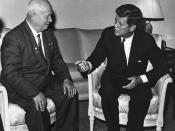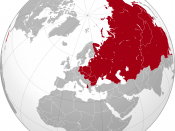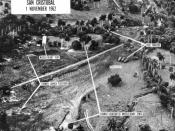John F. Kennedy's greatest triumph as President of the United States came in 1962, as the world's two largest superpowers, the Soviet Union and the United States, edged closer and closer to nuclear war. The Soviet premier of Russia was caught arming Fidel Castro with nuclear weapons. The confrontation left the world in fear for thirteen long days, with the life of the world on the line. Castro's rebellion in the south led to the final stages of US-Cuban relations and the alliance between the Soviet Union and Cuba. Once this alliance began, it opened a gateway for the Soviet Union to take lead in the arms race. The Soviet Union immediately acted by placing nuclear warheads on and around the island of Cuba. With the discovery of Russian missiles in Cuba, Kennedy was faced with the shocking presence of fear and discomfort. Fear for his family, his people, and fear for American government.
The Cuban Missile Crisis was a necessary risk. It was Americas duty to defend itself and its independence from the threat of destruction and the rapidly growing communist expansion.
Throughout the 1950's Fidel Castro has built a force of rebellion with one goal-change. By 1959 Castro forced Batista, the President of Cuba, to flee his country. On January 8th 1959, Castro led his armed revolutionaries into Havana which concluded his conquest on Cuba. Once in control of Cuba, Castro sent out one message. That was a message of ruthlessness and immorality throughout the world.
After leading an unsuccessful attack on an army barracks in Santiago in 1953, Castro had spent some time in prison. Once he was released he went to Mexico where he met Argentine revolutionary Che Guevara, and returned to Cuba in 1956. His tiny force fought guerilla warfare from the jungles and mountains...



The Cuban Missile Crisis
This is a big improvement over your 183 word essay of the same name. You can take care of the misspelling in the title by renaming your essay "The Cuban Missile Crisis." Your current title is too broad as there have been many clashes between America and communism. Other than the title, you've done a good job.
4 out of 4 people found this comment useful.